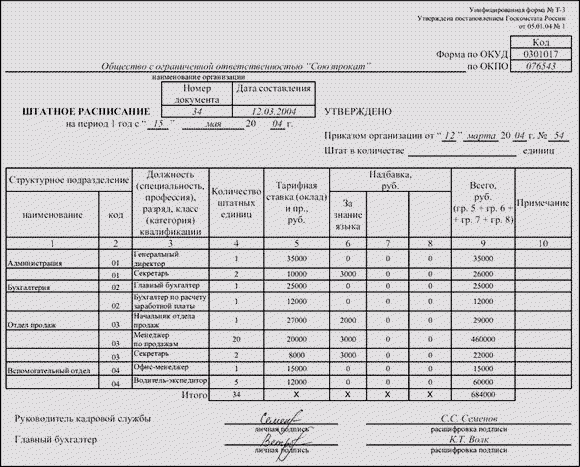The staffing of the enterprise is compiled in a table. It includes 10 columns. It is used to formalize the staffing, composition and structure of the enterprise. 
Document Specificity
Approval of the staff list is carried out by order of the head of the organization. This act may also be signed by an authorized person. One important nuance should be noted. Since the staffing order fixes the summary table, then all adjustments in it are carried out on the basis of a similar order of the head or authorized person. Consider this point in more detail.
Staffing
The sample can be adjusted in different volumes. Depending on this, a full or partial processing of the document will be carried out. So, if there will be a large number of changes, it is more convenient to reprint the entire schedule (create a new one). In any case, a new order will need to be issued to make adjustments.
Grounds
In practice, quite often situations arise when a change in staffing is necessary. In particular, this may be in such cases:
- Creation of new divisions in the structure of the company.
- Introduction of posts.
- Adjustment of tariff rates, surcharges.
- Change of job titles.
- Liquidation of units (department).
- Reduction of staff, posts.
Labor Code of the Russian Federation
Amendments to the staffing list entail an adjustment to the employment contract, which, in turn, must be fixed appropriately. As a rule, for such cases, it is necessary to comply with the deadlines, the consent of the employee and the fulfillment of other requirements provided for in the Labor Code. An example is the reduction in the staff or number of employees in an enterprise. According to Art. 180, part 2 of the Labor Code provides a guarantee to employees who are dismissed on the indicated basis. In particular, it is a question of the fact that they must be notified of the forthcoming procedure personally under the signature no less than 2 months before it begins. In this regard, changes to the staffing table are carried out from a certain date in accordance with the established period. 
Pivot table development
According to the Qualified Handbook on the positions of managers, specialists and other employees, the staffing table (a sample table is given in the article) can be made by an economist for work. Due to the fact that such an employee is far from every company, the management independently selects the employee on whom this work will be assigned. If the scheduling is imposed on the duties of an employee for whom this function is not specified in the labor contract or instructions, then the appointment is carried out by issuing an appropriate order. By this order, this work is introduced into the main activity of the employee.
Staffing form
The TC does not contain a direct requirement for a pivot table in each company. But according to the Decree of the State Statistics Committee, it is stipulated that the forms of accounting primary documentation for recording the activities of employees and their payment, including T-3 form (staffing table), are valid for organizations of all types of ownership. Until April 2001, the legislation did not establish requirements for the compilation of a summary table.With the introduction of standardized forms of accounting (primary) documentation, employers can use a new ready-made form of staffing. In 2004, a new Album of Unified Forms was published. In accordance with it, the T-3 form (staffing) was adjusted. 
Data compliance
Positions in the staff list must correspond to those specified in the employment contracts. If restrictions are envisaged in the Federal Law with the performance of work in specialties or professions, then their names must be consistent with the names and requirements given in qualified directories approved in the manner established by the Government. When establishing posts, the following special publications can be used:
- ETKS.
- Qualification reference book for employees, specialists and managers.
- OKPDTR.
Adjustment procedure
Changing staffing can be done in two ways. The first is a complete revision of the table. The new schedule, having the following registration number, must be approved by the decree on core activities. However, adjustments may be minor. In this case, they are drawn up by order. In this disposition, unlike the typical activity, there is no ascertaining part. The act can immediately begin with the word “I order”, since additional comments are not required for the approval and implementation of the schedule. If necessary, you can indicate the reasons for this procedure. They can become:
- Improving the structure of the company.
- Reorganization.
- Carrying out activities aimed at improving the work of individual units.
- Reduction or expansion of the production base.
- Optimization of management activities.
- Change of law.
- Planning and economic calculation of the personnel department, elimination of duplicate functions and so on.

When replacing previous posts in the schedule with new ones, changing their names, forming departments, it is necessary to make adjustments to the personnel documentation of employees. They, in turn, will depend on the innovations of the report card. In particular, it could be:
- The imposition of additional responsibilities.
- Transfer.
- Change in salary.
Renaming a specialty
Such changes to the staffing list do not entail adjustments to labor functions or work schedules. The name of the specialty or profession is a prerequisite for an employment contract. In Art. 73 of the Labor Code stipulates that, on the basis of changes in technological or organizational factors of activity, on the initiative of the employer, the adjustment of the essential clauses of the contract determined by the parties is allowed. However, a prerequisite must be observed. The employee's job function must remain the same. In addition, in Art. 73, a special procedure has been established in accordance with which an employee must be warned of proposed innovations no later than 2 months in advance. Making changes to the staffing table is carried out in this case by the written consent of the employee. After receiving it, the data of the personal card and work book are adjusted. 
New unit name
If the name of the department is present in the contract with the employee, then its change is carried out similarly to the above procedure. In this case also, the adjustment should not affect the immediate work functions or the essential conditions for carrying out activities in the specialty. For example, the change may be this: instead of the marketing department, a marketing research department has been introduced.
Transfer
According to Art. 72, it is considered a change in the essential terms of the contract or labor function.This refers, in particular, to the place of business, if this clause is fixed in the contract, duties and rights, characteristics of the conditions of activity, compensation and benefits, payment terms, vacation and work. Permanent transfer at the same company on the initiative of the employer is permitted with the written consent of the employee. The proposal is the first document in the process of execution. The following will be amendments to the contract, drawn up in writing and certified by the employer and employee. After the transfer order is issued (form T-5). The basis for this is a change in the clause of the contract. Further, the data of the personal card and work book are adjusted. 
New salaries, allowances
When deciding on an increase in rates, an appropriate order is issued in accordance with which the schedule is changed. Available are:
- Size increase.
- List of posts subject to change.
- The effective date of the adjustment.
According to Art. 57 of the Labor Code, the conditions under which workers are paid are entered into the contract with them. In this regard, changes that relate to premiums and rates should be made out in the same way as other adjustments to material points in the contract. In this case, an additional agreement must be concluded with the employees affected by the order. Accordingly, all employees who are responsible for maintaining relevant documentation should be familiarized with the order for these changes. 
Important point
Above the increase in premiums and rates is considered. This situation is considered conflict-free - in such cases there is no difficulty in obtaining the approval of employees for such adjustments. However, due to the deteriorating economic situation, employers often try to reduce employee rates unilaterally, guided by Art. 74. The norms of this article, however, can only be applied provided that the changes are caused by adjustments to technological or organizational factors. Economic reasons do not apply to them. Based on this, the employer is not entitled to reduce tariff rates unilaterally. The leader, of course, may try to get the approval of the employees, draw up an additional agreement to the contract. However, it should be remembered that any actions of employees to force the employer are always fraught with conflicts, disputes and financial consequences for the company.








